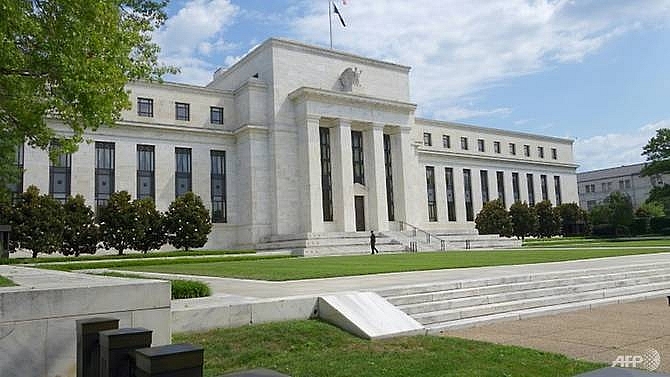US business optimism wanes over tariffs, rate hikes: Fed
 |
| Exterior view of the US Federal Reserve building in Washington, DC. (AFP/KAREN BLEIER) |
The Fed's "beige book" survey of the economy showed the impact of President Donald Trump's punitive import tariffs has become more widespread, with cost increases felt by manufacturers, retailers and restaurants, restraining demand.
Even so, most regions of the US showed modest or moderate growth, and there were continued reports of companies increasing wages and benefits to attract and retain qualified workers, the report said.
"Most districts reported that firms remained positive; however, optimism has waned in some (districts) as contacts cited increased uncertainty from impacts of tariffs, rising interest rates, and labour market constraints," the Fed noted.
Trump has imposed steep tariffs on steel, aluminium and about US$250 billion in imported goods from China, which has retaliated with tariffs on US goods. Washington and Beijing have agreed to negotiate a deal to resolve the dispute, but that could take another three months.
Wage increases - added to rising costs in more industries due to US tariffs on steel and aluminium and hundreds of billions of dollars in imports from China - could become a concern for the central bank as it works to head off inflation without slowing economic growth.
But the outlook reflected in the report has not changed much in recent months, and provides few signs that the expected increase in the Fed's benchmark lending rate in December will be postponed.
'PAIN POINT'
The report was prepared for the Fed's monetary policy meeting on Dec 18-19, which is expected to end with the fourth rate increase this year and the ninth in three years.
"Higher metals prices because of import tariffs continue to be a pain point for manufacturers and construction firms," according to reports from the Cleveland region.
"There were a number of reports of tariffs leading to higher prices further down the supply chain," including to retailers.
And several regions reported businesses were beginning to raise prices as their costs increase.
"Looking ahead six months, manufacturing firms continued to anticipate higher prices, with nearly 60 per cent of the firms expecting increases in prices paid and in prices received for their own goods," the Philadelphia Fed said.
At the same time, businesses nationwide say they are having trouble filling open positions, which in some cases has forced them to postpone expansion plans.
The Chicago Fed cites the growing problem of keeping existing workers.
"A number of contacts said that they had been 'ghosted,' a situation in which a worker stops coming to work without notice and then is impossible to contact."
Meanwhile, four of the 12 Fed districts reported slow or virtually no growth in October and November. If that pattern spreads, the central bank could be faced with trying to control rising prices amid slowing growth.
So while a December rate increase is expected by most economists, what the Fed will do next year is increasingly in doubt - and many analysts have cut their forecast down to just two or three next year.
What the stars mean:
★ Poor ★ ★ Promising ★★★ Good ★★★★ Very good ★★★★★ Exceptional
Related Contents
Latest News
More News
- 72 nations sign landmark Hanoi cybercrime convention (October 26, 2025 | 18:00)
- UN Secretary-General commends Vietnam’s global leadership (October 26, 2025 | 09:00)
- APEC finance ministers convene to tackle regional challenges (October 22, 2025 | 17:31)
- Rewiring global trade: ASEAN’s rise as supply chain hub (October 17, 2025 | 11:40)
- Vietnam attends first World Nuclear Week Forum in Russia (September 26, 2025 | 10:50)
- Vietnam attends 69th session of IAEA General Conference (September 16, 2025 | 10:00)
- ADB, WB pledge over 12 billion USD for ASEAN power grid, renewable energy projects (August 15, 2025 | 14:18)
- Lowy Institute proposes AI-based tobacco control solutions for ASEAN (August 15, 2025 | 14:14)
- Cloud computing policy to position Malaysia as regional hub by 2030 (August 15, 2025 | 14:11)
- Thailand, Cambodia suffer numerous cyber attacks (August 05, 2025 | 16:19)

 Tag:
Tag:





















 Mobile Version
Mobile Version